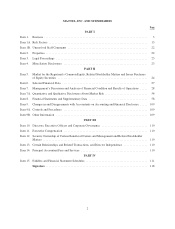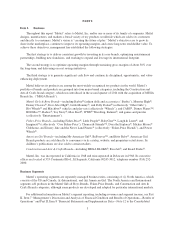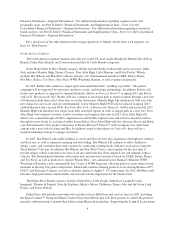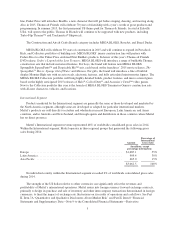Mattel 2014 Annual Report Download - page 14
Download and view the complete annual report
Please find page 14 of the 2014 Mattel annual report below. You can navigate through the pages in the report by either clicking on the pages listed below, or by using the keyword search tool below to find specific information within the annual report.television and radio commercials, magazine, newspaper, and internet advertisements, and social media.
Promotions include in-store displays, sweepstakes, merchandising materials, and major events focusing on
products and tie-ins with various consumer products companies.
During 2014, 2013, and 2012, Mattel incurred expenses of $733.2 million (12.2% of net sales), $750.2
million (11.6% of net sales), and $717.8 million (11.2% of net sales), respectively, for advertising and
promotion.
Sales
Mattel’s products are sold throughout the world. Products within the North America segment are sold
directly to retailers, including discount and free-standing toy stores, chain stores, department stores, other retail
outlets, and, to a limited extent, wholesalers. Mattel also operates several small retail outlets, generally near or at
its corporate headquarters and distribution centers as a service to its employees and as an outlet for its products.
Products within the International segment are sold directly to retailers and wholesalers in most European, Latin
American, and Asian countries, and in Australia and New Zealand, and through agents and distributors in those
countries where Mattel has no direct presence. Mattel also has retail outlets in Latin America and Europe that
serve as outlets for its products. American Girl products are sold directly to consumers, and its children’s
publications are also sold to certain retailers. Mattel has eighteen American Girl retail stores: American Girl
Place in Chicago, Illinois, Los Angeles, California, and New York, New York, and American Girl stores in
Alpharetta, Georgia, Bloomington, Minnesota, Charlotte, North Carolina, Chesterfield, Missouri, Columbus,
Ohio, Dallas, Texas, Houston, Texas, Lone Tree, Colorado, Lynnwood, Washington, McLean, Virginia, Miami,
Florida, Natick, Massachusetts, Orlando, Florida, Overland Park, Kansas, and Palo Alto, California, each of
which features children’s products from the American Girl segment. American Girl also has a retail outlet in
Oshkosh, Wisconsin that serves as an outlet for its products. Mattel also plans to open retail stores in Nashville,
Tennessee and Scottsdale, Arizona in 2015. Additionally, Mattel sells certain of its products online through
websites of one or more of its subsidiaries.
During 2014, Mattel’s three largest customers (Wal-Mart at $1.1 billion, Toys “R” Us at $0.6 billion, and
Target at $0.5 billion) accounted for approximately 35% of worldwide consolidated net sales. Within countries in
the International segment, there is also a concentration of sales to certain large customers that do not operate in
the US, none of which exceed 10% of net sales. The customers and the degree of concentration vary depending
upon the region or nation. See Item 1A “Risk Factors” and Part II, Item 8 “Financial Statements and
Supplementary Data—Note 12 to the Consolidated Financial Statements—Segment Information.”
Licenses and Distribution Agreements
Mattel has license agreements with third parties that permit Mattel to utilize the trademark, characters, or
inventions of the licensor in products that Mattel sells. A number of these licenses relate to product lines that are
significant to Mattel’s business and operations.
Mattel has entered into agreements to license entertainment properties from, among others, Disney
Enterprises, Inc. (including ©Disney characters such as Mickey Mouse, Disney Princess, Jake and the Never
Land Pirates, Planes, CARS and Toy Story from Pixar, and certain Disney films and television properties),
Viacom International, Inc. relating to its Nickelodeon®properties (including Dora the Explorer, and SpongeBob
SquarePants), Warner Bros. Consumer Products (including Batman, Superman®, and Justice League®), and
WWE Wrestling.
Royalty expense for 2014, 2013, and 2012 was $242.4 million, $246.9 million, and $240.2 million,
respectively. See “Commitments” and Part II, Item 8 “Financial Statements and Supplementary Data—Note 11
to the Consolidated Financial Statements—Commitments and Contingencies.”
8
























